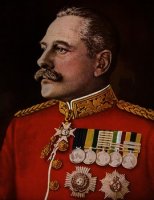
Worksheets and No Prep Teaching Resources
Reading Comprehension Worksheets
World War I

World War I
 Worksheets and No Prep Teaching Resources Reading Comprehension Worksheets World War I |
 World War I |
| edHelper's suggested reading level: | grades 5 to 7 | |
| Flesch-Kincaid grade level: | 6.75 |
|
British General Haig
By Jane Runyon |

|
 1 Sir Douglas Haig was born in Scotland in 1861. He would grow to be one of the most powerful and controversial generals in World War I. He attended the Royal Military Academy in England only one year. He went from there to the 7th Hussars as a cavalry officer. The cavalry believed that the only way to win a war was from the back of a horse, riding into battle. He served nine years of his early military career in India. He came back to his homeland at the beginning of the century. In 1906, he became the Director of Military Training in London. It was his job to put together an army. Rumors were flying throughout Europe of a threat being posed by German forces. He was to make sure the British army was ready in case the German threat became a reality. Having accomplished this task, he was sent back to India where he took charge of the Indian army.
1 Sir Douglas Haig was born in Scotland in 1861. He would grow to be one of the most powerful and controversial generals in World War I. He attended the Royal Military Academy in England only one year. He went from there to the 7th Hussars as a cavalry officer. The cavalry believed that the only way to win a war was from the back of a horse, riding into battle. He served nine years of his early military career in India. He came back to his homeland at the beginning of the century. In 1906, he became the Director of Military Training in London. It was his job to put together an army. Rumors were flying throughout Europe of a threat being posed by German forces. He was to make sure the British army was ready in case the German threat became a reality. Having accomplished this task, he was sent back to India where he took charge of the Indian army. |
Create Weekly Reading Books
Prepare for an entire week at once! |
| Leave your feedback on British General Haig (use this link if you found an error in the story) |
 |
World War I
|
 |
Social Studies
|
 |
United States
|
|
|
|
|
 | Fifty States Theme Unit |
 |
Document Based Activities |